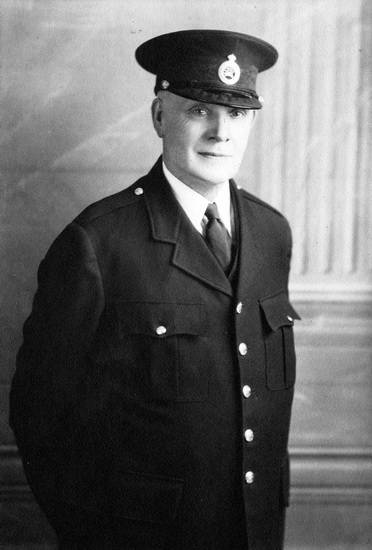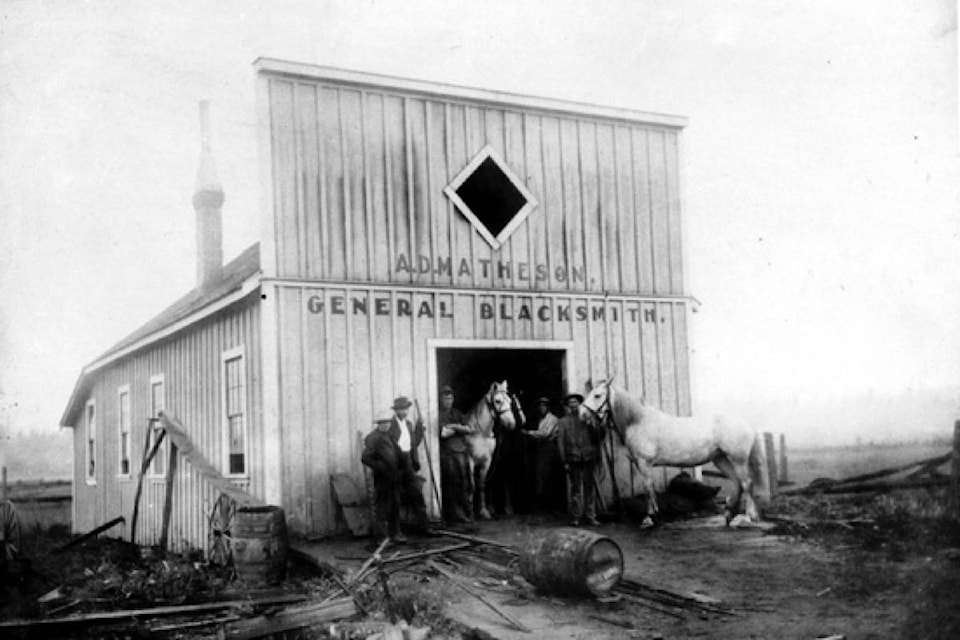Sue Bryant
Cloverdale Reporter
Surrey may have looked a lot different around the turn of the twentieth century, but the municipal council was faced with issues we’d find familiar. One of the council’s biggest concerns of the time was the area’s rapid population growth and its correlation with crime.
Considering Surrey was comprised of several communities covering a relatively vast expanse of land, crime rates were fairly low. Which was a good thing, because in the early 1880s, the closest full-time police officers were in New Westminster. It was up to the local residents to keep the peace.
In 1887, Surrey appointed its first official police constable, Edmund T. Wade, who worked on a part-time, as-needed basis. While council minutes confirm that handcuffs and a revolver were purchased for his use the following year, it would seem his duties were few and far between thanks to a close-knit community and vigilant neighbours.
But as time went on and the population increased to about 5,000 and spread out over 316 sq.-km, the municipal council agreed it was time to hire a dedicated police officer to manage law enforcement. For this duty, they chose Alexander Dougal Matheson.
Matheson was born in 1869 in Lucknow, Ontario. When he was 17, he trekked west to B.C., where he worked at the Brunette Mill at Elgin as a bull-team driver. While working at the mill, he apprenticed as a blacksmith and used those skills to travel to the Yukon gold fields during the “Trail of ’98.”
Matheson returned from the Yukon in 1900 and settled in Cloverdale, opening his own blacksmith shop in the centre of town – today, the Cloverdale Reporter’s office stands where Matheson’s blacksmith shop once was, on what is now 56A Avenue.
Five years after setting up shop, Matheson was appointed Surrey’s first full-time police constable. The work, however, did not warrant full-time duties at the start, nor did it pay enough at $20 a month to provide a living wage. Matheson continued on with his blacksmith business.
He married Christina McCrimmon of Cloverdale in 1907, and they had two children, Frank and Isobel.
A policeman of many strengths
At well over six feet, Matheson was a strong, husky man who had been a wrestler in his younger days, but he was more well-known for his gentle level-headedness and his ability to connect with people.
Jim Craig, who served as the last chief of Surrey Police before the detachment was turned over to the RCMP in 1951, remembered Matheson’s strengths in an oral history interview.
“He was well known and well liked. And he was exceptionally strong physically,” said Craig. “I can recall once going into a blacksmith’s shop and they had one of these large anvils that they worked with. And the blacksmith at that time said to him, ‘If you can lift that anvil with one hand, I’ll buy the coffee.’ And he did. He removed his coat and put his hand on the horn and he lifted the anvil straight up.”
It was said that Matheson never carried a gun when carrying out his duties as a police officer. Owing to his strength and tenacity, he had a knack of talking to people and getting to the bottom of the story.
John Pearson recalls in his book, “Land of The Peace Arch” a time when a young boy was picked up for burglarizing homes in Port Kells.
Matheson found the boy and, while talking to the him, found out that the boy and his family were going through hard times. Matheson pulled $5 out of his own wallet (more than $100 today) and gave it to the boy. According to Pearson, the boy never crossed the law again and grew up to be a well-respected member of the community.
Surrey Police: from part-time peacekeeping to a full-time force
In 1908, a terrible murder occurred in Hazelmere, an incident that would become a turning point in law enforcement in Surrey.
On June 9, 1908, Mary Morrison was walking home from the post office with her 8-year-old daughter. While sitting on a log to rest, she was grabbed from behind and her throat was cut. Her daughter ran to the first house she could find to raise the alarm, which was owned by the Brown family, and is where Redwood Park can be found today. When the Browns accompanied the young girl back to the scene, they found Mary Morrison mortally wounded and no one else to be seen.
The event triggered a huge outcry both in the Lower Mainland and the Washington State. Matheson, members of the B.C. Provincial Police from New Westminster and Vancouver, and community members organized armed search parties looking for the suspect. He was eventually tracked down in Blaine, Wash. where he was arrested and brought back to Canada.
At the time, there were no jails in the area so the suspect, James Jenkins, had to be kept in the back of the Municipal Hall until he could be brought to the B.C. Penitentiary in New Westminster. He would be tried within the month, convicted and put to death for his crime in December 1908.
In the next year, Matheson became police chief of the newly formed Surrey Police. It was now a full-time job and also required another police officer on the force; Joseph Drinkwater worked in traffic control, now that vehicles were becoming more prevalent on the roads.
Matheson’s many roles in the community
Matheson also became the first Fire Marshall, and collected dues for the municipality. (It was said that once he took over collecting the monies for the Cloverdale Opera House, it was paid off and making money within the year.)
Matheson would continue as the police chief until his retirement in 1937. The police force gradually increased to a dozen men during his tenure. He was highly regarded by all who had occasion to be in contact with him.
He passed away in 1957 at the age of 87 and is buried at Forest Lawn Cemetery in Burnaby.
Sue Bryant is an oral historian and a member of the Surrey Historical Society. She is also a digital photo restoration artist, genealogist and volunteers at the Surrey Museum and Surrey Archives.

